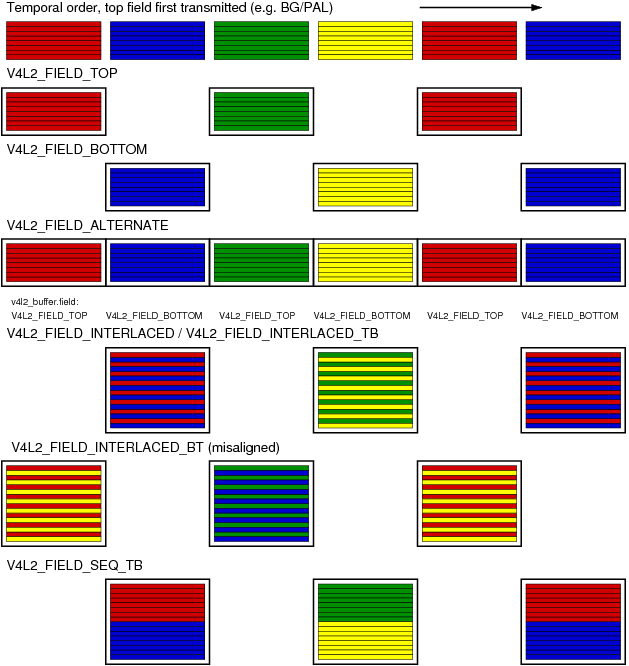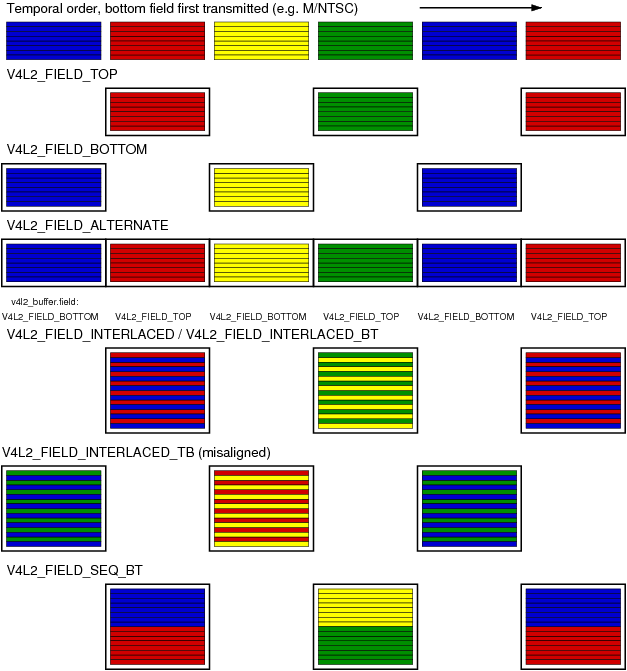We have to distinguish between progressive and interlaced video. Progressive video transmits all lines of a video image sequentially. Interlaced video divides an image into two fields, containing only the odd and even lines of the image, respectively. Alternating the so called odd and even field are transmitted, and due to a small delay between fields a cathode ray TV displays the lines interleaved, yielding the original frame. This curious technique was invented because at refresh rates similar to film the image would fade out too quickly. Transmitting fields reduces the flicker without the necessity of doubling the frame rate and with it the bandwidth required for each channel.
It is important to understand a video camera does not expose one frame at a time, merely transmitting the frames separated into fields. The fields are in fact captured at two different instances in time. An object on screen may well move between one field and the next. For applications analysing motion it is of paramount importance to recognize which field of a frame is older, the temporal order.
When the driver provides or accepts images field by field rather than interleaved, it is also important applications understand how the fields combine to frames. We distinguish between top (aka odd) and bottom (aka even) fields, the spatial order: The first line of the top field is the first line of an interlaced frame, the first line of the bottom field is the second line of that frame.
However because fields were captured one after the other, arguing whether a frame commences with the top or bottom field is pointless. Any two successive top and bottom, or bottom and top fields yield a valid frame. Only when the source was progressive to begin with, e. g. when transferring film to video, two fields may come from the same frame, creating a natural order.
Counter to intuition the top field is not necessarily the older field. Whether the older field contains the top or bottom lines is a convention determined by the video standard. Hence the distinction between temporal and spatial order of fields. The diagrams below should make this clearer.
All video capture and output devices must report the current
field order. Some drivers may permit the selection of a different
order, to this end applications initialize the
field field of struct v4l2_pix_format before
calling the VIDIOC_S_FMT ioctl. If this is not desired it should
have the value V4L2_FIELD_ANY (0).
Table 3.9. enum v4l2_field
V4L2_FIELD_ANY | 0 | Applications request this field order when any
one of the V4L2_FIELD_NONE,
V4L2_FIELD_TOP,
V4L2_FIELD_BOTTOM, or
V4L2_FIELD_INTERLACED formats is acceptable.
Drivers choose depending on hardware capabilities or e. g. the
requested image size, and return the actual field order. struct v4l2_buffer
field can never be
V4L2_FIELD_ANY. |
V4L2_FIELD_NONE | 1 | Images are in progressive format, not interlaced.
The driver may also indicate this order when it cannot distinguish
between V4L2_FIELD_TOP and
V4L2_FIELD_BOTTOM. |
V4L2_FIELD_TOP | 2 | Images consist of the top (aka odd) field only. |
V4L2_FIELD_BOTTOM | 3 | Images consist of the bottom (aka even) field only. Applications may wish to prevent a device from capturing interlaced images because they will have "comb" or "feathering" artefacts around moving objects. |
V4L2_FIELD_INTERLACED | 4 | Images contain both fields, interleaved line by line. The temporal order of the fields (whether the top or bottom field is first transmitted) depends on the current video standard. M/NTSC transmits the bottom field first, all other standards the top field first. |
V4L2_FIELD_SEQ_TB | 5 | Images contain both fields, the top field lines are stored first in memory, immediately followed by the bottom field lines. Fields are always stored in temporal order, the older one first in memory. Image sizes refer to the frame, not fields. |
V4L2_FIELD_SEQ_BT | 6 | Images contain both fields, the bottom field lines are stored first in memory, immediately followed by the top field lines. Fields are always stored in temporal order, the older one first in memory. Image sizes refer to the frame, not fields. |
V4L2_FIELD_ALTERNATE | 7 | The two fields of a frame are passed in separate
buffers, in temporal order, i. e. the older one first. To indicate the field
parity (whether the current field is a top or bottom field) the driver
or application, depending on data direction, must set struct v4l2_buffer
field to
V4L2_FIELD_TOP or
V4L2_FIELD_BOTTOM. Any two successive fields pair
to build a frame. If fields are successive, without any dropped fields
between them (fields can drop individually), can be determined from
the struct v4l2_buffer sequence field. Image
sizes refer to the frame, not fields. This format cannot be selected
when using the read/write I/O method. |
V4L2_FIELD_INTERLACED_TB | 8 | Images contain both fields, interleaved line by line, top field first. The top field is transmitted first. |
V4L2_FIELD_INTERLACED_BT | 9 | Images contain both fields, interleaved line by line, top field first. The bottom field is transmitted first. |

